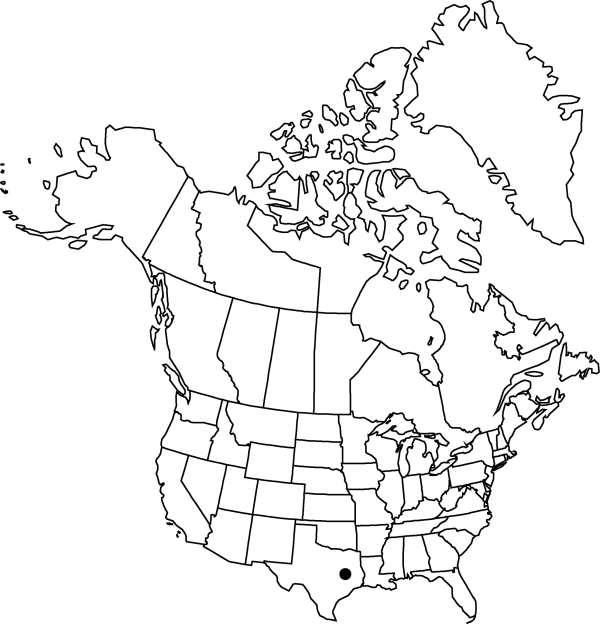Difference between revisions of "Abronia macrocarpa"
Brittonia 24: 148, fig. 1. 1972.
FNA>Volume Importer |
FNA>Volume Importer |
||
| Line 17: | Line 17: | ||
}}<!-- | }}<!-- | ||
| − | --><span class="statement" id="st- | + | --><span class="statement" id="st-undefined" data-properties=""><b>Plants </b>perennial. <b>Stems</b> ascending to semierect, slightly to moderately branched, elongate, glandular-pubescent to viscid. <b>Leaves</b>: petiole 0.5–4 cm; blade ovate to elliptic, 2–5 × 1.5–3.5 cm, margins entire or occasionally ± repand and slightly undulate, surfaces glandular-puberulent. <b>Inflorescences</b>: peduncle longer than subtending petiole; bracts ovate to elliptic, 7–13 × 4–6 mm, papery, glandular-pubescent; flowers 20–75. <b>Perianth</b>: tube pink to magenta, 18–32 mm, limb magenta, 8–10 mm diam. <b>Fruits</b> broadly turbinate or cordate in profile, 8–15 × 6–12 mm, 0.7–2 times as long as wide, scarious, with a low, conic, inconspicuous beak at apex; wings 5, often twisted, usually smooth, occasionally rugose, not reticulate veined at apex, without cavities.</span><!-- |
-->{{Treatment/Body | -->{{Treatment/Body | ||
| + | |phenology=Flowering spring, opportunistically after summer rains. | ||
|habitat=Sand dunes | |habitat=Sand dunes | ||
|elevation=100 m | |elevation=100 m | ||
| Line 40: | Line 41: | ||
|basionyms= | |basionyms= | ||
|family=Nyctaginaceae | |family=Nyctaginaceae | ||
| + | |phenology=Flowering spring, opportunistically after summer rains. | ||
|habitat=Sand dunes | |habitat=Sand dunes | ||
|elevation=100 m | |elevation=100 m | ||
| Line 47: | Line 49: | ||
|publication year=1972 | |publication year=1972 | ||
|special status= | |special status= | ||
| − | |source xml=https://jpend@bitbucket.org/aafc-mbb/fna- | + | |source xml=https://jpend@bitbucket.org/aafc-mbb/fna-data-curation.git/src/9216fc802291cd3df363fd52122300479582ede7/coarse_grained_fna_xml/V4/V4_121.xml |
|genus=Abronia | |genus=Abronia | ||
|species=Abronia macrocarpa | |species=Abronia macrocarpa | ||
| − | |||
| − | |||
| − | |||
| − | |||
| − | |||
| − | |||
| − | |||
| − | |||
| − | |||
| − | |||
| − | |||
| − | |||
| − | |||
| − | |||
| − | |||
| − | |||
| − | |||
| − | |||
| − | |||
| − | |||
| − | |||
| − | |||
| − | |||
| − | |||
| − | |||
| − | |||
| − | |||
| − | |||
| − | |||
| − | |||
| − | |||
| − | |||
| − | |||
| − | |||
| − | |||
| − | |||
}}<!-- | }}<!-- | ||
-->[[Category:Treatment]][[Category:Abronia]] | -->[[Category:Treatment]][[Category:Abronia]] | ||
Revision as of 13:56, 27 July 2019
Plants perennial. Stems ascending to semierect, slightly to moderately branched, elongate, glandular-pubescent to viscid. Leaves: petiole 0.5–4 cm; blade ovate to elliptic, 2–5 × 1.5–3.5 cm, margins entire or occasionally ± repand and slightly undulate, surfaces glandular-puberulent. Inflorescences: peduncle longer than subtending petiole; bracts ovate to elliptic, 7–13 × 4–6 mm, papery, glandular-pubescent; flowers 20–75. Perianth: tube pink to magenta, 18–32 mm, limb magenta, 8–10 mm diam. Fruits broadly turbinate or cordate in profile, 8–15 × 6–12 mm, 0.7–2 times as long as wide, scarious, with a low, conic, inconspicuous beak at apex; wings 5, often twisted, usually smooth, occasionally rugose, not reticulate veined at apex, without cavities.
Phenology: Flowering spring, opportunistically after summer rains.
Habitat: Sand dunes
Elevation: 100 m
Discussion
Of conservation concern.
Abronia macrocarpa is on the United States endangered species list; and it is in the Center for Plant Conservation’s National Collection of Endangered Plants.
Selected References
None.

